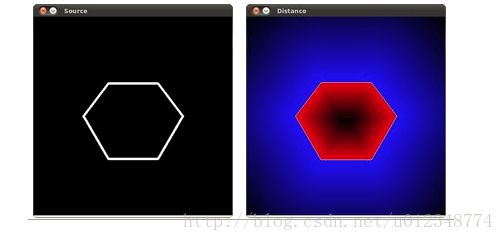Opencv: pointPolygonTest函数使用
参考:
http://blog.csdn.net/fuyou25/article/details/53467204
https://docs.opencv.org/2.4/modules/imgproc/doc/structural_analysis_and_shape_descriptors.html?highlight=pointpolygontest#pointpolygontest
https://docs.opencv.org/2.4/doc/tutorials/imgproc/shapedescriptors/point_polygon_test/point_polygon_test.html
根据Opencv文档,pointPolygonTest的参数及解释如下:
函数形式
C++: double pointPolygonTest(InputArray contour, Point2f pt, bool measureDist)
1
函数作用
判断一个点是否在一个contour的内部还是外部。
1
参数解释
contour – 输入findContour提取到的边缘.
pt – 需要检测的点.
measureDist – 为真,则计算检测点到边缘的距离,为负值在外部,0在边上,正值在内部。为假,则返回-1(在contour外部)、0(在contour上)、1(在contour内部。
1
2
3
Demo(代码和示意图版权归Opencv所有,此处仅作示例,参考链接在文首)
#include "opencv2/highgui/highgui.hpp"
#include "opencv2/imgproc/imgproc.hpp"
#include
#include
#include
using namespace cv;
using namespace std;
/** @function main */
int main( int argc, char** argv )
{
/// Create an image
const int r = 100;
Mat src = Mat::zeros( Size( 4*r, 4*r ), CV_8UC1 );
/// Create a sequence of points to make a contour:
vector
vert[0] = Point( 1.5*r, 1.34*r );
vert[1] = Point( 1*r, 2*r );
vert[2] = Point( 1.5*r, 2.866*r );
vert[3] = Point( 2.5*r, 2.866*r );
vert[4] = Point( 3*r, 2*r );
vert[5] = Point( 2.5*r, 1.34*r );
/// Draw it in src
for( int j = 0; j < 6; j++ )
{ line( src, vert[j], vert[(j+1)%6], Scalar( 255 ), 3, 8 ); }
/// Get the contours
vector
Mat src_copy = src.clone();
findContours( src_copy, contours, hierarchy, RETR_TREE, CHAIN_APPROX_SIMPLE);
/// Calculate the distances to the contour
Mat raw_dist( src.size(), CV_32FC1 );
for( int j = 0; j < src.rows; j++ )
{ for( int i = 0; i < src.cols; i++ )
{ raw_dist.at
}
double minVal; double maxVal;
minMaxLoc( raw_dist, &minVal, &maxVal, 0, 0, Mat() );
minVal = abs(minVal); maxVal = abs(maxVal);
/// Depicting the distances graphically
Mat drawing = Mat::zeros( src.size(), CV_8UC3 );
for( int j = 0; j < src.rows; j++ )
{ for( int i = 0; i < src.cols; i++ )
{
if( raw_dist.at
{ drawing.at
else if( raw_dist.at
{ drawing.at
else
{ drawing.at
}
}
/// Create Window and show your results
char* source_window = "Source";
namedWindow( source_window, CV_WINDOW_AUTOSIZE );
imshow( source_window, src );
namedWindow( "Distance", CV_WINDOW_AUTOSIZE );
imshow( "Distance", drawing );
---------------------
作者:Stone_Yannn
来源:CSDN
原文:https://blog.csdn.net/u012348774/article/details/78882084
版权声明:本文为博主原创文章,转载请附上博文链接!
